Iris ‘Sparkling Rose’ (sibirica). siberian Iris. Elegantly formed with a fall that narrows to the end and tall standards. the colouring is a rich winey-pink with excellent markings on the fall, changing in the throat from yellow through white to a hint of purple, all enhanced by darker veining. 90cm
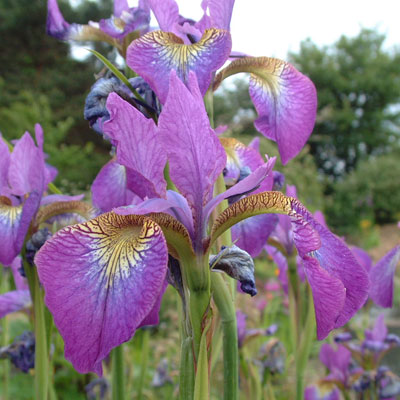
Iris sibirica ‘Sparkling Rose’
Iris ‘Ewen’ (sibirica). siberian Iris. ‘Ewen’ has flowers that are mid way between the stiff upright form of ‘Flight of Butterflies’ and the highly flared form of ‘Ruffled Velvet’. The falls are well rounded with a colouring that is papal purple, overlaid with darker veining. They have a good white signal and yellow throat. Beautiful moisture loving Iris which will produce a dense clump of grassy leaves and a profusion of flowers in early summer. 70cm.
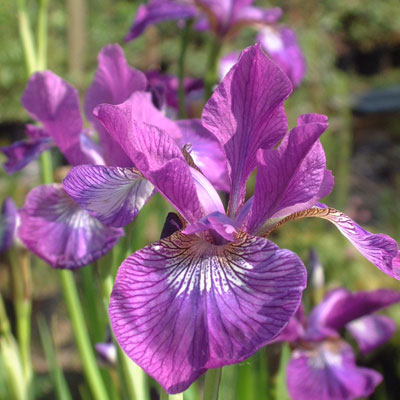
Iris sibirica ‘Ewen’
Iris ‘Helen Astor’ (sibirica). siberian Iris. An old variety, but one with much to recommend it. The flowers are quite full with well rounded falls and broad standards, both in a rich wine red. The falls are beautifully marked with a lovely veined white signal and yellow throat. A lovely moisture loving iris which will produce a dense clump of narrow grassy foliage and a forest of tall stems bearing its richly veined velvety maroon flowers in early summer. 75cm.
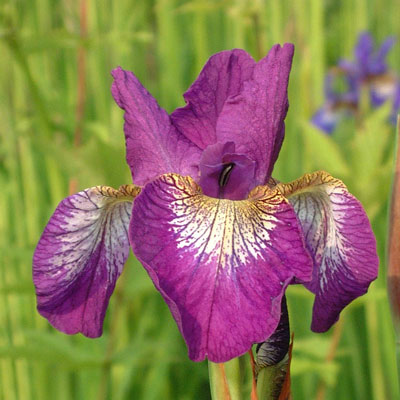
Iris sibirica ‘Helen Astor’
Iris ‘Pink Haze’ (sibirica). Siberian Iris. A beautiful Siberian Iris with sugary pink petals. The falls are a darker shade than the standards and are further enhanced with fine crimson rays. The richer substance of the petals, the fact that it flowers about a month later than your average Siberian Iris (ie mid June) lead us to suspect that an Iris ensata played some part in its parentage. Furthermore it is quite tall (95cm (3′) in flower) and really is best in moisture retentive soil in sun to semi-shade. We find the other Siberian Irises pretty tough and tolerant of drier soils. Winner of a Morgan Wood medal. (AIS)
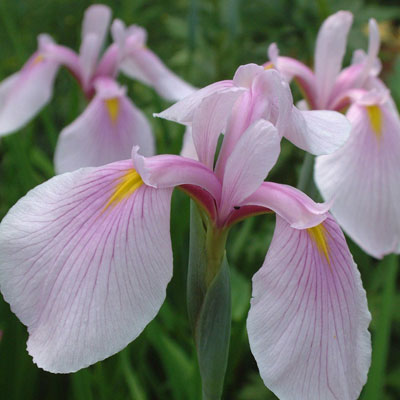
Iris sibirica ‘Pink Haze’
Iris ‘Flight of Butterflies’ (sibirica). The flowers of this variety are a rich royal blue. The falls are held hanging down and are well rounded in shape with a narrow neck. The fall is particularly well marked, yellow towards the throat and white further out, all heavily overlayed with dark veins. A moisture loving iris producing dense clumps of narrow grassy leaves and a forest of stems bearing flowers in May . 75cm. mid summer
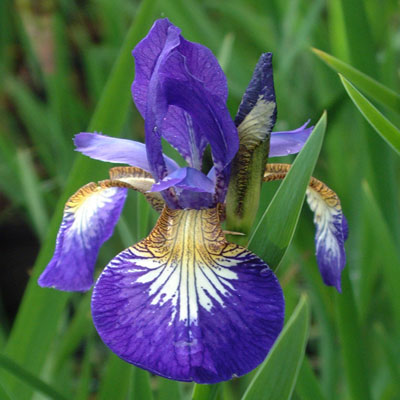
Iris sibirica ‘Flight of Butterflies’
Iris ‘Blue King’ (sibirica). Siberian Iris. A Rich Royal blue variety with a good vertical shape to the flowers with tall standards and hanging falls. The falls are richly marked with a yellow throat and veined white detail. A beautiful moisture loving Iris which will produce a dense clump of grassy leaves and a profusion of rich royal blue flowers in mid summer. 90cm
Iris ‘Ruffled Velvet’ (sibirica). The flowers of this variety are relatively flat with excellent form, the darkness of the purple being the perfect setting for the delicate markings on the fall petal in the throat. Beautiful moisture loving Iris which will produce a dense clump of grassy leaves and a profusion of rich velvety dark purple flowers in mid summer. one of the shorter varieties at just 75cm. Winner of a Morgan Award (AIS)
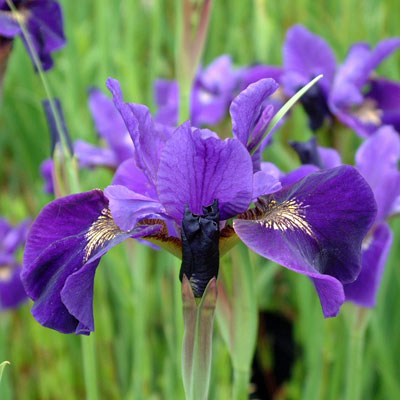
Iris sibirica ‘Ruffled Velvet’
Iris ‘Persimmon’ (sibirica). This is very elegant variety, tall with flowers of an excellent shape. The standards are long and the falls well rounded and held nicely out from the flower with great grace. The colour of the petals is a rich powder blue with a very well lined white and yellow throat.

Iris sibirica ‘Persimmon’
Iris ‘Butter and Sugar’ (sibirica). siberian Iris. A shorter variety with a really elegant flared shape to the flower in a very attractive shade. The broad falls are a lovely creamy yellow, darkening towards the throat, whilst the flared standards are a complimentary creamy white. A slightly more delicate variety worthy of careful placing. 65cm. mid summer. Winner of a Morgan-Woods medal (AIS)
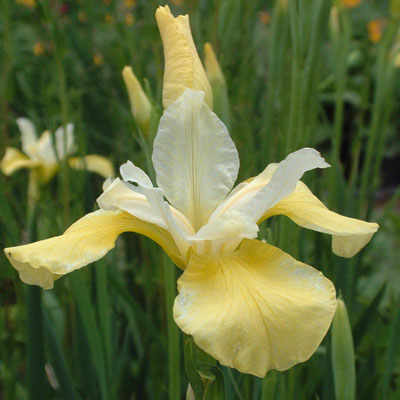
Iris sibirica ‘Butter and Sugar’
Iris chrysographes. Quite unique among the Iris is Iris crysographes with its inky black velvety petals. It produces two fragrant blooms on each, relatively short (45cm) flowering spike in June and July. The foliage is lax and grassy. Ideally for a sunny spot with moisture retentive soil, but shade for part of the day may be appreciated.
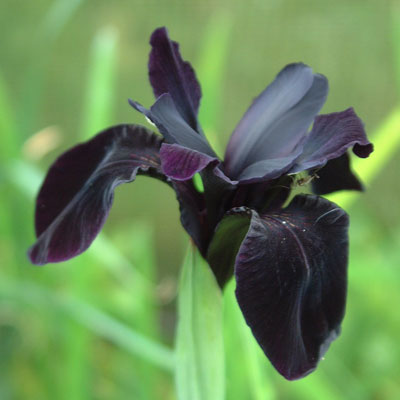
Iris chrysographes
“What we like about Iris sibirica apart from its slender grace and lovely blues and whites…is its willingness to do anywhere and to continue doing for years without asking for division.” – A.T. Johnson
The Genus iris is large, containing some 200 plus species. They cover a huge range of forms and habitats, which I won’t go into here. As we are largely only concerned with iris of two related sections, the Siberian Irises and the Sinosiberian Irises.
The rather inaccurately named Siberian Irises ( Iris sibirica ) come from an area from Russia Westwards into Central Europe (Blame Linnaeus who gave them their name). The related Iris sanguinea does grow in Siberia, with Iris typhifolia coming from China. These three have been extensively interbred to give us the range of Iris cultivars that now class as ‘Siberian Irises’. They are plants for a moist soil of any type providing it is not excessively acid or alkaline. Whilst moisture is required, they do not tolerate waterlogging. Established plants will cope with short periods of drought.
They are very elegant in flower with plants varying from 30-120cm in height.
The flowers are good for cutting
The section designated SinoSiberian Irises contains the species, Iris chrysographes and Iris pseudacorus, the Yellow flag. The name Yellow flag comes from the fluttering of the yellow fall. Many of its numerous other names come from corruptions of the Anglo-Saxon word for a sword, alluding to the leaves, though the unusual ‘Cheiper’ comes from the noise made by Children blowing the leaves between their thumbs like a reed.
The yellow flag can be grown equally successfully in the open garden or in very wet sites, wetter than conditions in which Iris sibirica would be happy. The green leafed form can be too vigorous for all but naturalistic plantings, but the variegated form is quite well behaved.
Iris pseudacorus is the Fleur-de-Lis of France. Louis VII chose the flower as his emblem when he joined the Crusaders’ fight against the Saracens. Fleur-de-Louis gradually became corrupted through Fleur-de-Luce to Fleur-de-Lis. Lys is a river in Flanders, on whose banks Iris pseudacorus grows in profusion. Earlier than this, the Iris was taken by King Clovis as his heraldic symbol, replacing the three toads he previously used. Facing defeat, King Clovis was persuaded to pray to the Christian God of his wife Clothilde. When he achieved victory he converted to Christianity and made the change of symbol, Iris being the symbol of the Virgin Mary.
Iris pseudacorus. Iris aquatic, Iris lutia, Yellow Flag, Fleur de Luce, Dragon Flower, Myrtle Flower, Fliggers, Flaggon, Segg, Sheggs, Cheiper, Cucumbers, Daggers, Jacob’s Sword, Galdyne, Meklin, Levers, Livers, Shalder

















































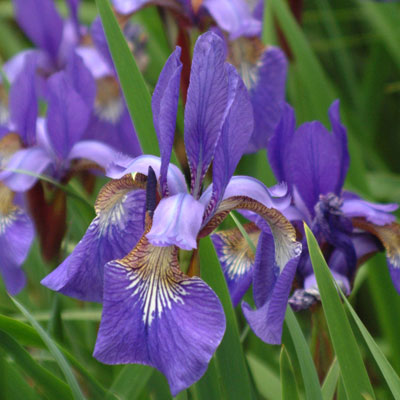









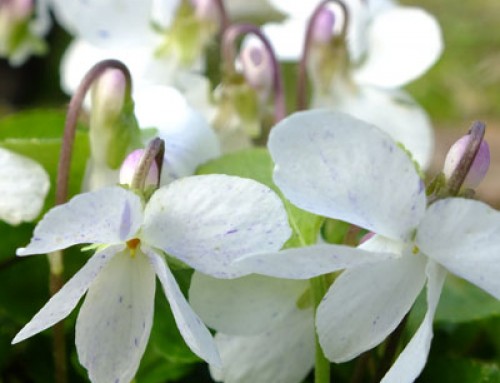

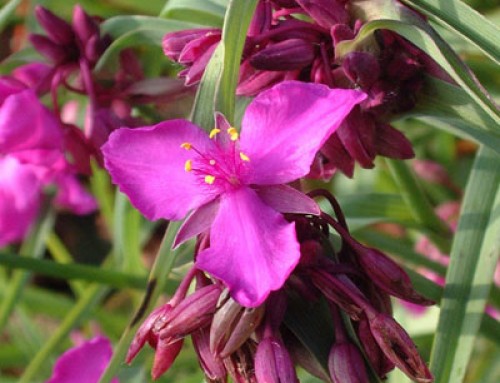
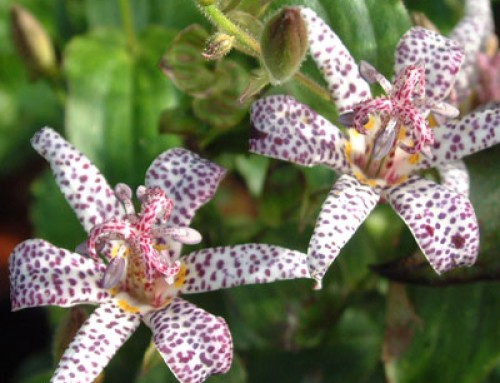
Leave A Comment
You must be logged in to post a comment.